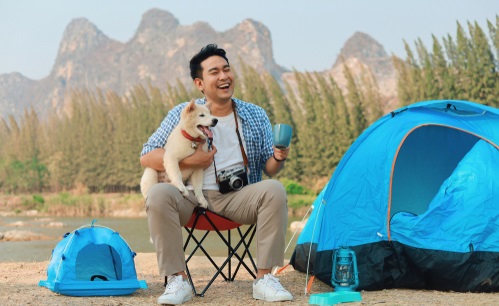Owning a puppy – especially for the first time – is an experience unlike any other. And for anyone who loves the great outdoors, bringing the family pooch on a camping excursion is an exciting prospect. After all, what’s better than exploring nature with a man’s best friend? From sunny days by the lake to throwing a Frisbee by the campsite, having one’s beloved fur baby along for the adventure just makes the memories that much sweeter. However, it’s important to follow certain guidelines when camping with a puppy. Read on to learn more about canine safety tips and tricks, along with helpful information for new pet parents.
Assess Your Pet: Is Your Pup Ready For Camping?
While the idea of a puppy tagging along during an outdoor trip is delightful in theory, it’s essential for dog moms and dads to assess the situation. Before bringing him camping, folks must ask themselves, “is he truly ready for this?” In other words, although a pup may be playful, friendly, and eating well, he still may not be mature enough to handle the ins and outs of being in a new environment.
For example, if he’s still running and barking at every single squirrel or bird he sees, camping in the woods may be too much stimulation for him to handle. Is he fully house trained yet? If he is still chewing up the sofa arms or routinely peeing on the carpet, he’ll likely cause damage to the tent or other camping gear in tow. Finally, if a dog isn’t able to follow simple commands such as ‘stay’, ‘heel’, or respond to his own name, it may not be safe to bring him into the wilderness just yet. If any of these scenarios sound familiar, dog owners may want to hold off a bit before bringing their pup on his first camping trip. Instead, wait until he’s a bit older and worldlier so those first outings are good (and not stressful) memories!
Know Your Environment: Choosing The Right Campsite For Dogs
It should come as no surprise that puppies are distracted by almost anything – a loud noise, another animal, or even an unfamiliar person – and in other cases, it may not be anything at all! Young dogs are naturally curious, sometimes high-strung, and easily stimulated by any number of things in their environment. Although their innocence and spirited nature is part of puppy’s charm, these same beloved traits can also pose a safety risk in the wild – and an annoyance to other campers.

With that said, dog folks will be wise to choose their campground carefully. Before planning a trip with him, do some research – find out as much as possible about the campsite in advance, preferably online for the most accurate info. First and foremost, make sure that the destination of choice allows pets – although most national parks, campgrounds and other outdoor areas permit dogs, certain locations may have restrictions. Once you’re ready to book a reservation, be sure to review the park and state’s most up-to-date rules and regulations regarding camping with pets before visiting. Check with local government organizations online to verify such details.
Below, a few key tips to follow when planning a camping trip with a puppy:
Socially Distance FTW: Although it’s become the ‘new normal’, social distancing in this instance isn’t only for the safety of people. By picking a campsite that is far away from other fellow campers, it provides a buffer between the family dog and surrounding campground neighbors. Whether he’s barking incessantly or simply needs lots of room to run around without encountering other dogs (or people) within close proximity, choosing a somewhat remote campsite is a win-win for everyone. By doing so, it provides both pet parents and pups a safe amount of distance to enjoy themselves peacefully – and in turn, helps avoid disturbing other outdoor enthusiasts.
Made In The Shade: While humans have the ability to wear sunglasses and cool off via removing layers of clothing, dogs don’t have that same luxury. More importantly, dogs cannot sweat like people do – because they cool off by panting and through their paws, canines tend to overheat more easily than their pet parents do. That’s why it’s essential to find a campsite that offers plenty of shade, particularly in the warmer months. In the instance where he needs extra options to stay in the shade, there are special dog tents and tarps specifically designed for unobstructed air flow to set up on the campsite. These structures will not only keep him from overheating, but protect him from harmful UV rays. However, during a hike, simply pausing under a tree for a few minutes will give overheated pups a chance to cool off. Check out this article for additional tips on camping with dogs in hot weather.
ID, Please: Besides keeping the family pooch on a leash at all times, be certain that he’s wearing his collar with a clearly-marked ID tag – and if he’s not microchipped yet, consider doing so for his long-term safety.

Chowtime Checklist: When people are camping for an extended period of time, the combination of fresh air, vigorous hiking, swimming and other activities tend to stoke the appetite. Similarly, dogs get extra hungry, too – by expending additional energy, puppies will need more hydration and nutrition than usual. Therefore, fur baby folks should plan accordingly: be sure to bring plenty of his favorite dog food, cbd for dogs, and fresh water for the duration of the trip. Google map the surrounding areas in advance to see where there are local supermarkets or stores to replenish supplies. For puppies who are normally fed once a day, try feeding him twice – or simply increase his snack intake over the course of the day. Always have fresh water available, and be sure to have a collapsible bowl on hand, too. Finally, for campsites near any nearby water bodies, be sure that the water is safe to drink before inquisitive puppies start sipping. Specifically, pet folks need to be wary of blue green algae in both fresh and salt water – read here for valuable info about this potentially dangerous outdoor hazard to dogs.
Camping First-Aid: Unlike their owners, pups can’t communicate when they’re in pain. That’s yet another reason why pet parents must stay vigilant when camping with dogs. In addition to keeping an eye on their behavior, actions, and body language, a dog owner must come prepared with adequate canine first-aid for camping excursions. This dog first aid article provides an in-depth list of hiking and camping basics from an actual veterinarian. A few possible scenarios to keep in mind while camping with a puppy include:
- Ticks: If he’s not already taking a flea and tick medication, speak with a trusted vet prior to planning a camping trip. In a pinch, tick collars are an effective option for puppies, too. Pet owners may wish to ask their vet for the safest tick collar options for pups if medication isn’t a possibility. For dog parents who prefer a natural alternative, there are even botanical collars such as the Arava Flea & Tick Prevention Collar, which utilizes essential oils to repel fleas and ticks. During the visit to the vet, a dog owner may also wish to discuss the pup’s vaccine history to ensure his safety – check out this article featured on the American Kennel Club site for a complete guide for puppy vaccinations.
- Cuts, blister or abrasions of the paws: Although pet parents want to protect their precious pups whenever possible, they are not immune to the accidental injury. However, certain precautions can help – be sure to scan the areas around the campsite for broken glass, thorns, hot coals, and other potential catalysts for getting hurt or causing a canine paw pad injury. Surveying the grounds carefully before letting a puppy roam can help prevent him from getting injured, but owners can go one step further – safeguard his paws with dog boots. Engineered to protect the delicate padding on a dog’s paws, there are a variety of sizes to fit pups of nearly every breed – and nearly every type of adventure.
- Beware of wild animals: Along with camping comes the possible risk of encountering wild animals – after all, it’s their natural habitat and their home. But while coyotes, bear, moose and other predatory creatures may avoid people in most circumstances, they’re not afraid of puppies. Therefore, it’s imperative that dog owners keep a watchful eye on puppies at all times, particularly after dusk. Be sure to keep your new puppy on a leash or tether for his own safety, and make sure it’s secure if attached to a zip line or a nearby tree to ensure he doesn’t wander off.

Quality Camping Cuddles: One of the best advantages of camping with a puppy? Why, it’s the cuddling, of course – in fact, experts recommend that dog moms and dads keep puppies close by at night when it’s time to hit the hay. Since most puppies don’t have enough body fat to keep them warm as the temperatures plummet overnight, sleeping with their owners is the safest bet. Avoid letting young pups sleep on the ground, and keep them wrapped with blankets or a children’s sleeping bag for extra warmth. The best way to prevent a puppy from catching a chill at night is snuggling up to his family. In addition to keeping him cozy and relaxed, dozing off with one’s faithful companion in the wilderness provides a feeling of safety and security for everyone – and that’s a memory that will warm the heart of pet parents for years to come.
Sources Cited:
- Hagemeier, Heidi. “Camping with Dogs: How to Navigate Rules and Regulations.” REI Co-Op Journal (rei.com), October 26, 2017, https://www.rei.com/blog/camp/camping-with-dogs-how-to-navigate-rules-and-regulations. Accessed November 21, 2020.
- Henderson, Carrie. “5 Tips For Camping With Your Puppy.” The Outbound Collective (theoutbound.com), October 21, 2015, https://www.theoutbound.com/carrie-henderson/5-tips-for-camping-with-your-puppy. Accessed November 21, 2020.
- Carrick, Evie. “11 Helpful Tips for Camping With Dogs.” Travel + Leisure (travelandleisure.com), July 26, 2020, https://www.travelandleisure.com/trip-ideas/pet-friendly-travel/camping-with-dogs-tips. Accessed November 21, 2020.




